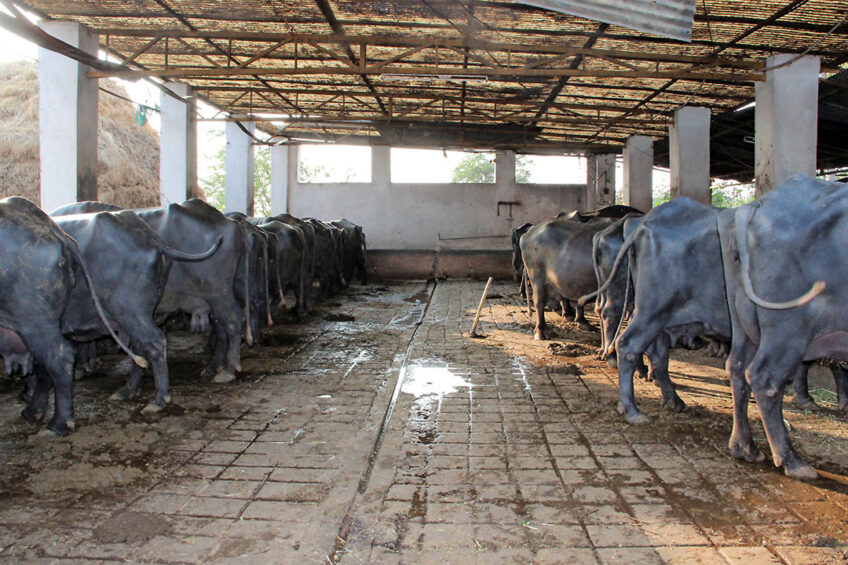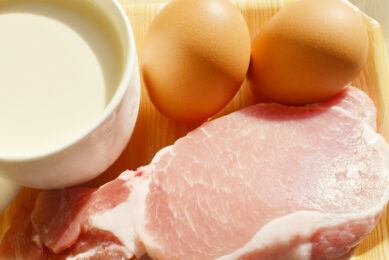Indian dairy: Big, but still traditional

India is the largest dairy producer in the world. At the same time, dairy farming is complicated in this country, as the Hindu religion makes it difficult to sell off old cows and bull calves. Dairy Global visited a farm, dedicated to water buffalo, to learn more.

For Indian standards, the cattle farm of Sunil Jagannath Badhale and his son Sumit Shrikant can be considered huge. The farm has 12 dairy cows and 438 water buffalo. The average farm size in India is two cows per farm. Badhale has dedicated itself to water buffalo, because many Indians prefer buffalo milk over normal cow’s milk. There is a large age variation in the herd of farmer Badhale. The youngest lactating cow is 3 years old, the oldest cow is 20. The average annual production is approximately 1,200 litres of milk per year. Water buffalo give less milk than the traditional Indian cow, but there is a much higher milk price involved in it. He can sell buffalo milk for € 0.75 per litre, while cow’s milk yields € 0.50 per litre.
|
Higher fat content in buffalo milk
Buffalo milk is higher in fat content, which makes it ideal for cheese making for example. In general, buffalo milk has a fat content of 8% and a protein content of 4.5%, compared to a cow’s milk that has a 3.9% fat and a 3.2% protein. Mr Badhale does not know the exact composition of his milk because he doesn’t have it measured externally. He does notice the effects of a change in the ration of the buffalo. The changes in the animals diets means that the milk becomes slightly fatter or less fat. The farmer sells all of the milk to street shops in the region. These customers pay well and compared to dairy processors, they don’t have any difficult criteria for the milk. The milk just has to be tasty and good.

15 employees that do all the work
Despite the scale of the farm, the business is still run in a quite traditional way. The water buffalo are housed side by side in simple open barns. Each barn houses about 30 cattle and each stable has its own caretaker. This means that the farm has a total of 15 employees that take care of the animals, who are not per se specialised in one task. All the employees are involved in feeding, cleaning, washing the cattle and milking. Milking is still done manually.

Mr Badhale has no land in use. All the animal feed materials are purchased and all manure is removed from the farm. The ration of the water buffalo consists mainly of energy-rich leaves from sugar cane, corn stalks (the sweet miniature corn cobs are eaten by the people), lentil pods, brewers grain and rice straw. Each water buffalo gets about 40 kilos of these feed ingredients a day. The feed is supplemented with 50 grams of ‘additives’. The farmer says he doesn’t know exactly what is in the additive mix, but he says it is mainly vitamins and not antibiotics. The feed costs per bufffalo is € 0.44 per day. He sells the manure to grape growers in the area that give him around € 25 per wagon of manure.

Natural insemination with bulls
Each stable of 30 cows has its own bull. A water buffalo calves once every two years. All buffalo are naturally inseminated. As soon as a cow is in heat, it is tied to a fence outside the barn, after which the cow is inseminated by a bull, always three times. Only after 2.5 months, the farmer knows whether the insemination has been successful. If not, a new attempt will follow. He does not use equipment to determine gestation. After 2.5 years, just before the first heifer calves in the house are ready for breeding and have to be inseminated for the first time, the bull is replaced by a ‘fresh’ one. This way inbreeding is prevented.

Sacred cows cannot be killed
Cows are sacred in Hinduism, and should not be hurt, let alone be slaughtered. The slaughter and eating of bovine animals is only allowed in eight off the 29 Indian states. Beef is eaten by Muslims, who make up 14% of the population in India. In May 2017, the Hindu nationalist BJP government imposed a ban on the slaughter of cattle, but in July 2017 this decision was reversed by court, because the consequences for the Indian Muslim population and the dairy industry in the country were too big. But where should all the old milking cows and buffalo go? This remains a hot topic in the Indian society, because on a regular basis, Islamic cattle transporters are still attacked by extremist Hindus. What does Mr Badhale actually do with its old milking cows and bull calves?

Mr Badhale seems to find this a difficult topic to talk about and actually a no-go area to discuss. After a little while, he explains that the bull calves are kept on the farm for 2.5 years, and then sold as work animals because in India it is common practice to use water buffalo as work animals to pull carts on the streets. A young bull for this purpose can be sold around € 250. The old milking cows stay on the farm, he explains. However, a stable with old milking cows was not seen on the farm during the visit. According to the interpreter, many cows also go to a so-called ‘goshala’, a state-financed rest home for old cows. That sounds very noble, but what happens in practice is often a different story. According to the Indian dairy expert Sira Abdul Rahman, dean at the Bangalore Veterinary College, the cows are more or less left to their own fate. But Mr Badhale continues to emphasise that no cow goes to the slaughter house. Perhaps the latter is the most sensible answer to give in India.
Production figures remain stableAccording to the Q4 2018 dairy update from Dutch agrofood banker Rabobank, India will see an increase in domestic milk supplies in the first few months of 2019, which in turn will lead to additional skimmed milk powder (SMP) manufacturing and stocking. As expected, the government has increased export subsidies to 20% in order to export surplus SMP. In addition, state-sponsored benefits are also in play and expected to last until March 2019. Rabobank experts write in the report that milk production estimates for the current year (2018/19, April – March) remain unchanged and are expected to surpass 180 million tonne. SMP and raw milk prices have also largely remained unchanged over the last quarter of 2018, and they are also not expected to move much in the first quarter of this year. Also worth mentioning is the fact that dairy processor Fonterra announced its re-entry into the Indian dairy sector by way of a joint venture with Future Consumer, a leading grocery retailer in the country. The intention of the joint venture is to produce a range of consumer and foodservice dairy products that will help meet the growing demand for high-quality dairy nutrition in India. They are planning product launches this year. |
Large dairy sector in IndiaIndia is the world’s largest dairy producer. According to the most recent figures from the Indian Ministry of Agriculture from 2017, more than 355 million cows and buffalo are kept in India for dairy production. Production in 2017 amounted to 165.4 million tons of dairy, more than 11 times as much as the Netherlands for example. In addition, with 1.28 billion inhabitants, the ales market for dairy products also has immense potential. However, the dairy sector is hampered by the country’s religion and cultural customs. The majority of the population are Hindu, who believe the cow is a sacred animal. Water buffaloes, unlike cows, are not sacred, but are generally treated in the same way. Cows may be kept and used commercially, but Hindus can not kill or eat cows. |
Join 13,000+ subscribers
Subscribe to our newsletter to stay updated about all the need-to-know content in the dairy sector, two times a week.


 Profile
Profile








